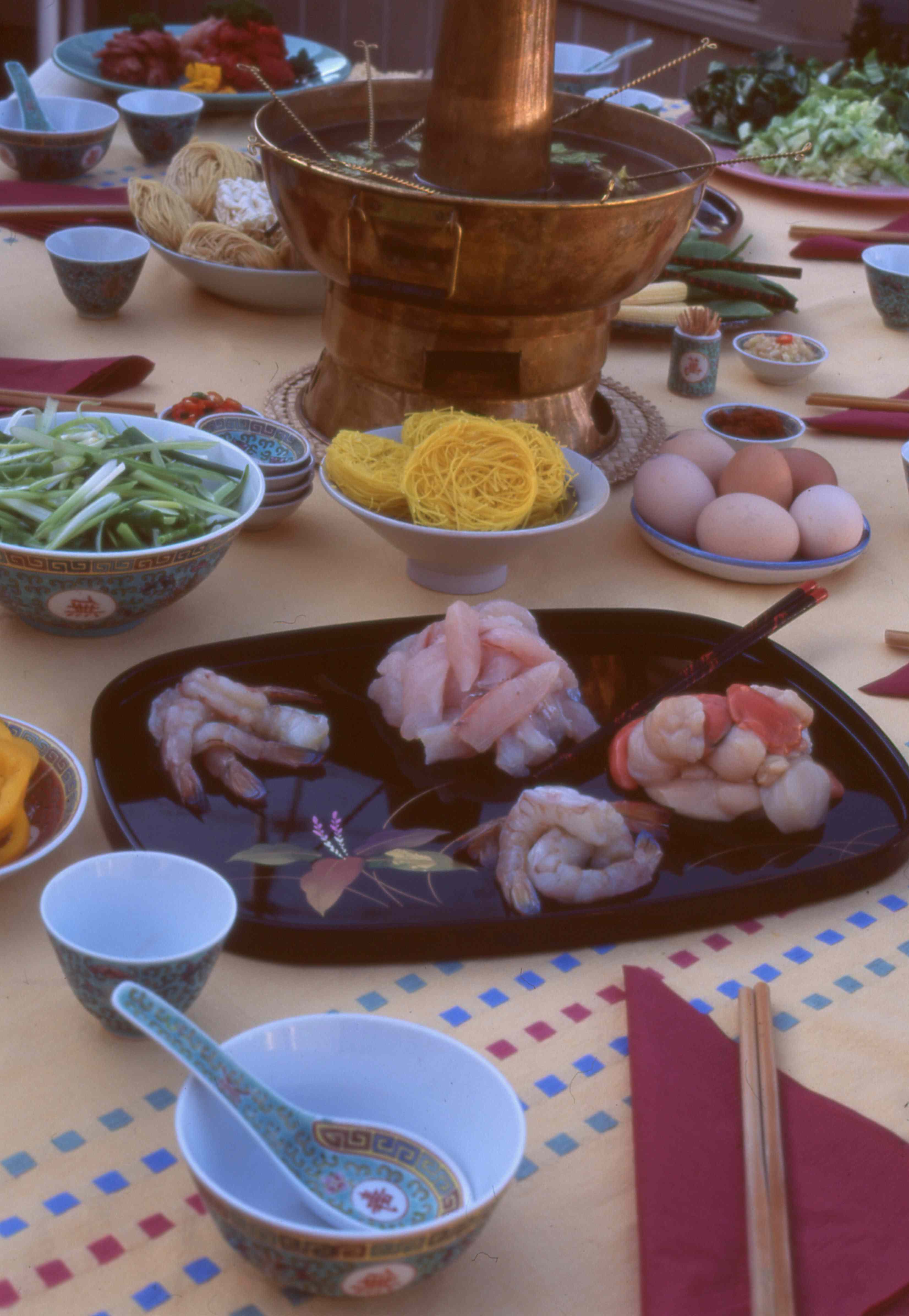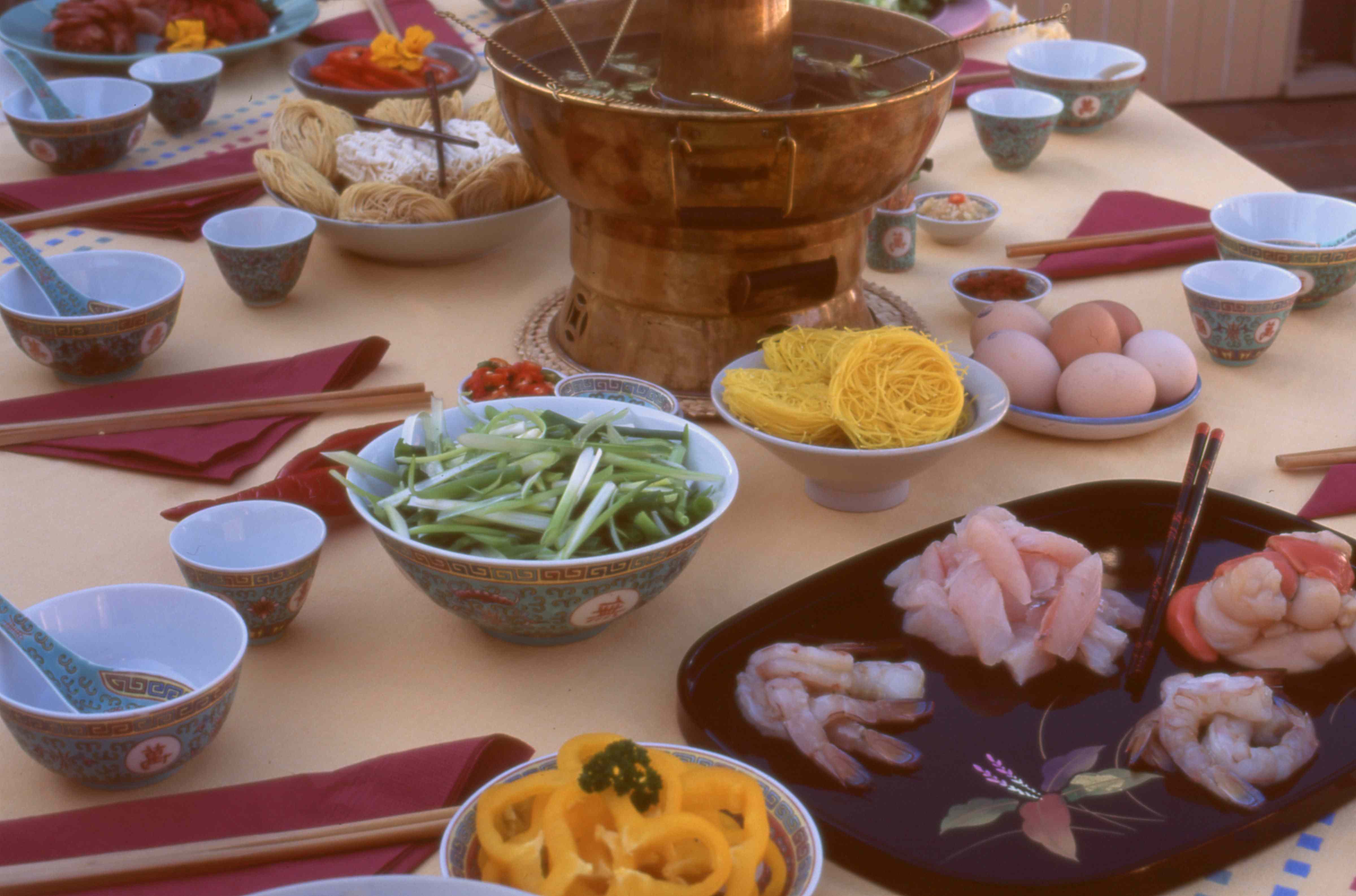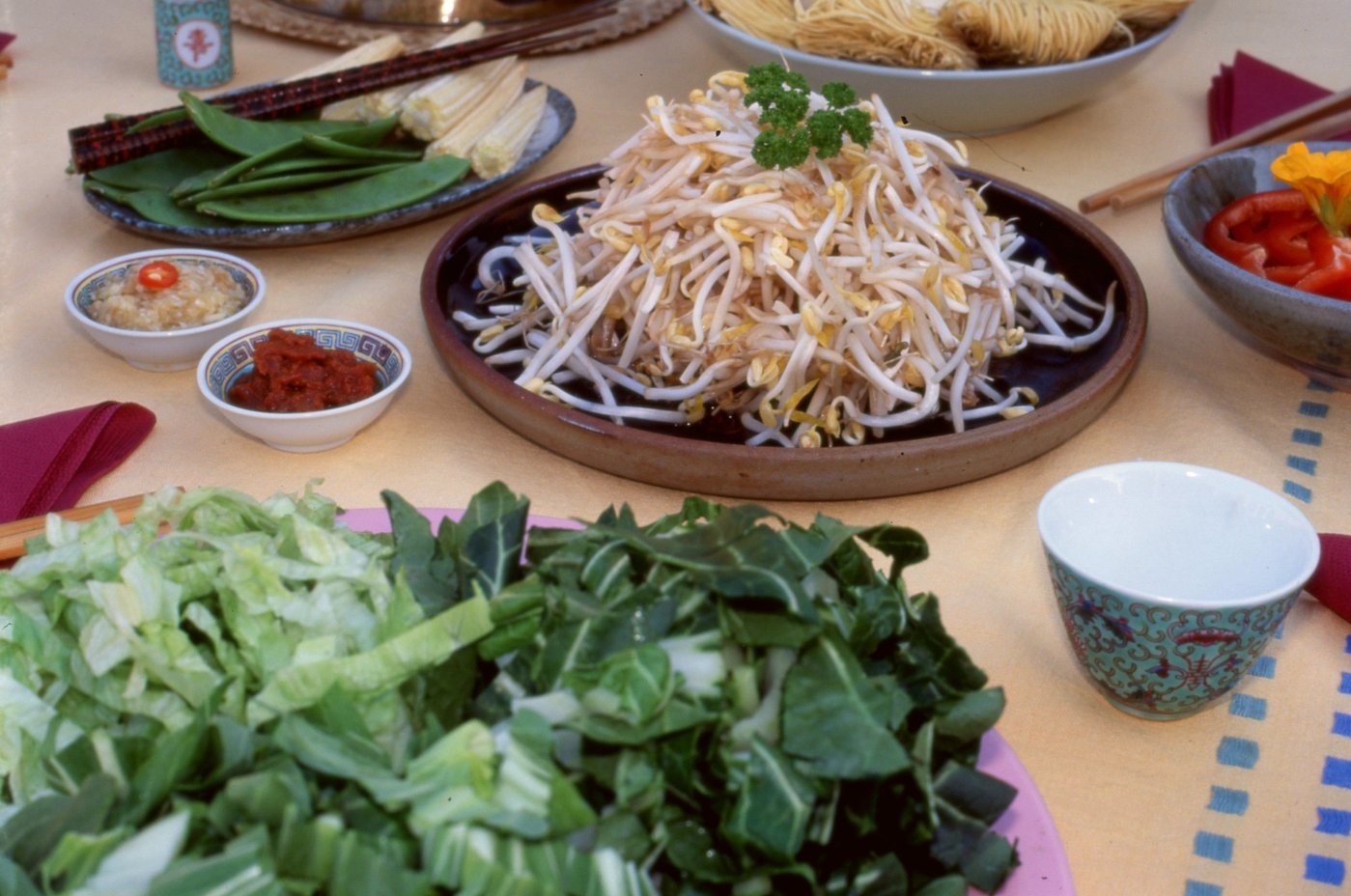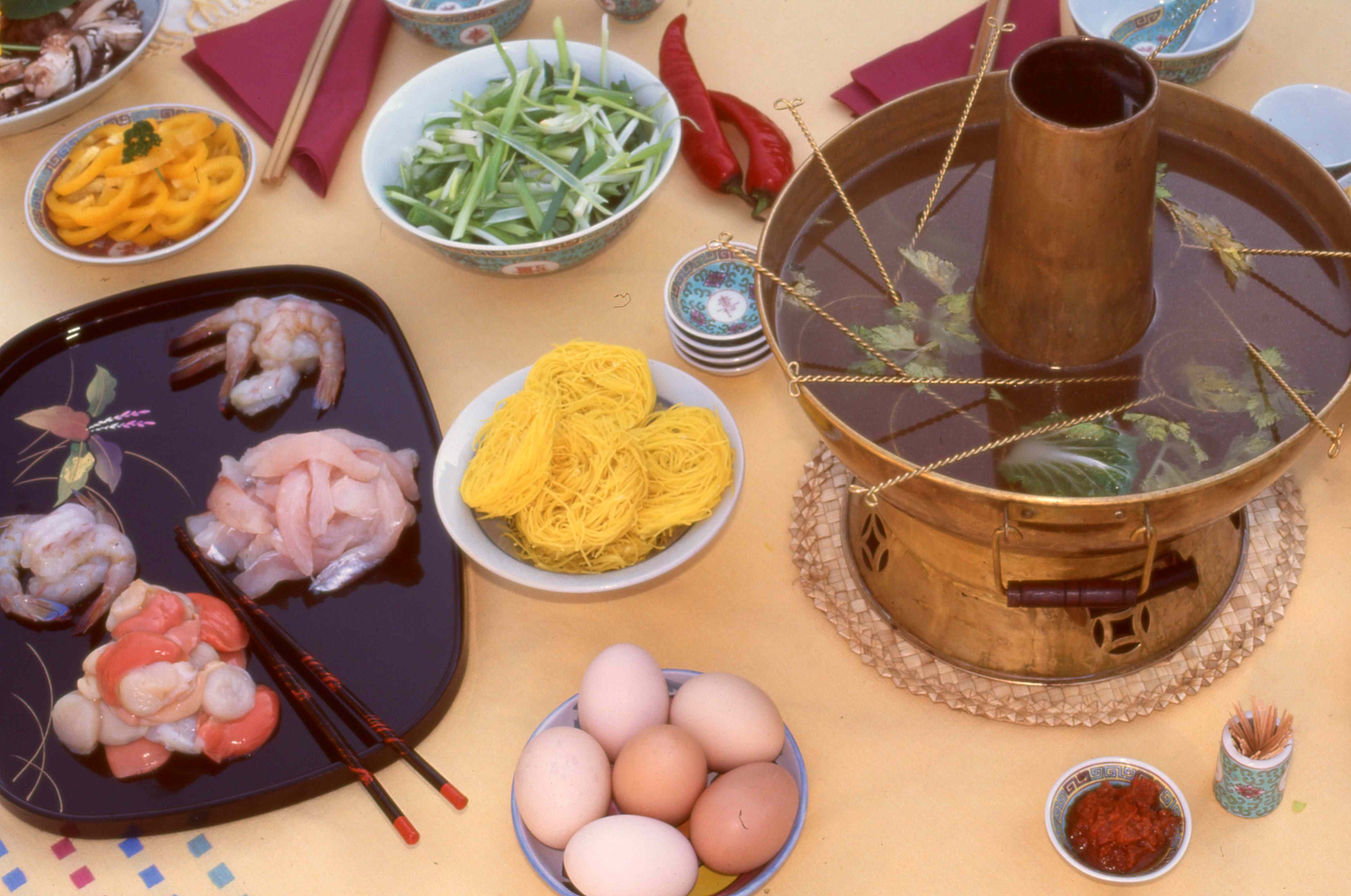This post is from an article we wrote for Club Marine magazine in 1997.
The food shots date from that period too.
(Use the Print button at the top of this page for a hard copy or pdf of the recipe in this post.)
Many of us are familiar with the Swiss fondue, where bread is dunked into melted cheese bubbling away over a burner in the centre of the table. There are numerous variations not using cheese, including meat fondues and chocolate fondues.
A similar style, often called steamboat cooking, exists in many Asian cuisines. We have eaten Mongolian and Korean versions. However, most memorable was a Malaysian steamboat in a little village in the Cameron Highlands, north of Kuala Lumpur. A charcoal-fired cauldron with a central chimney and a moat of bubbling stock was in the centre of the table. Around this impressive cooking utensil were numerous containers of different meats, seafoods, noodles and vegetables to be cooked in the liquid. These we dropped into the stock for a few minutes, then scooped them out to be eaten with various sauces and condiments. The stock, which had increased in flavour, was drunk as a soup at the end of the meal.
An Asian steamboat is a whole meal and experience in itself. It is ideal for a sunny afternoon or a balmy evening. It is much fun for all concerned, and with everyone cooking their own selection of ingredients fondue-style, the meal will be quite an extended one. Preparation does take some time, but the cooking part is a breeze!
In the following recipe we have not given exact quantities for ingredients. Instead we have given a range of ideas from which you can construct an interesting meal. Ensure there are plenty of ingredients to choose from, selecting from what is given below. Make sure they are well washed, peeled, etc. and cut to a size or thickness that will enable them to be cooked in the broth in a few minutes. Allow plenty of “greens”, such as bok choy, as they are very popular. Any leftovers can be used the next day.
The steamboat requires some carbohydrate. Numerous types of Asian egg or rice noodles are available in supermarkets and Asian grocery shops. Packets of instant noodles, like those in two-minute noodle packs, are widely available, and work well with this dish.
Most of the preparation can be done well beforehand.
Sauces
Make up several dipping sauces and condiments. Consider using some of the following:
- equal quantities of garlic and ginger crushed together with some salt
- soya sauce
- sliced chilli; coriander leaves; sliced lemon grass
- chilli and tomato relish
- mango chutney
- spicy plum sauce
Use at least one sweet sauce. If you use manufactured sauces, ensure they are of good quality and not tainted with metallic or artificial flavours.
Cooking utensil
Do not be concerned if you do not have a traditional steamboat cooker, as it is easy to improvise. Try a fondue set or camping stove with a methylated spirits burner. Or several bricks could be set up with a spirit burner, or very strong candles, in the middle. Small but powerful spirit burners can be bought quite cheaply from camping or disposal stores. Test out the method beforehand as there must be enough heat generated to keep the stock bubbling for an hour or so. Above all, do ensure that the cooking method you choose is very stable and fire safe, for example by setting it on tiles or bricks in the middle of the table.
A friend of ours, who was born near the Cameron Highlands, works wonders with an electric fry pan. You might be able to borrow a couple or three!
The cooking utensil for the stock needs to hold 350 to 500 ml of stock per person. A very deep frying pan is ideal or a wide saucepan that does not have very high sides. If the utensil is not large, keep reserved stock hot on the stove. Our photograph shows special wire scoops for rescuing the cooked meat, etc., however, slotted spoons work just as well. Provide everyone with small bowls, chopsticks and spoons.
Stock
- 350 to 500 ml per person
- chicken, pork or mild fish-flavoured stock
Meat and Fish
- 150 to 200g per person
- lean beef, pork or chicken, thinly sliced
- white fish, cubed
- raw prawns
- scallops
- fish balls
Vegetables
- bok choy or Chinese cabbage, sliced
- spinach leaves
- snow peas
- bean shoots
- spring onions, diced
- ordinary or other mushrooms, sliced
- red, yellow or green capsicum, diced
- asparagus, diced
Other ingredients and accompaniments
- noodles, about 80-100g per person
- raw eggs
- salt and pepper
- dipping sauces (see above)
Preparation
Prepare all the meat and vegetables and arrange on small platters or in bowls. Prepare the dipping sauces and put into small saucers. Ensure these are all on the table before the stock arrives.
When ready to start, bring the stock to the boil on your normal household stove, then transfer to the burner in the middle of the table. Adjust the heat so that the stock is simmering or bubbling slowly. (As ingredients are added by the diners, the temperature will drop and will take a minute or so to recover.)
Allow everyone to cook small portions of their chosen ingredients at their own pace, scooping them out into their bowl and eating with their chosen condiments. Top up the stock as necessary.
When everyone has finished, the stock should be quite flavoursome and ready to drink. For a special effect and lovely taste, break one or more eggs into the bubbling stock and stir vigorously with a fork or chopsticks. The eggs should set in streams. Ladle into bowls.
Degree of difficulty: 4/5 (reasonably difficult) as the success is all in organisation and the preparation of quality ingredients.






